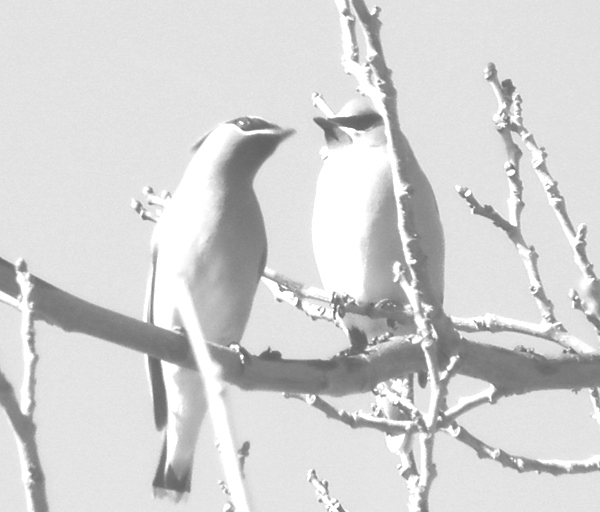 BIRDS, THEIR CALLS, FLIGHT PATTERNS, FEEDING HABITS AND MIGRATIONS — have been used by augurs over the centuries to foretell or to anticipate future events. Recently, the U.S. Department of the Interior issued a report, The State of the Birds 2014, marking the 100th anniversary of the extinction of the passenger pigeon. They begin the report with a quote by Aldo Leopold, “The pigeon was no mere bird, he was a biological storm.”
BIRDS, THEIR CALLS, FLIGHT PATTERNS, FEEDING HABITS AND MIGRATIONS — have been used by augurs over the centuries to foretell or to anticipate future events. Recently, the U.S. Department of the Interior issued a report, The State of the Birds 2014, marking the 100th anniversary of the extinction of the passenger pigeon. They begin the report with a quote by Aldo Leopold, “The pigeon was no mere bird, he was a biological storm.”
The report noted that one flock, estimated to be a billion birds strong, “was said to be 300 miles long; it took 14 hours, from sun up to sun down, for the flowing river in the sky to pass.” Just forty years later on September 1, 1914, the last passenger pigeon died. The dramatic loss of birds, to me, does not “augur” well for our own future.
The authors of the current report on the state of birds say they act “as indicators of ecosystem health,” and the report looks at the habitats bird species are dependent upon. They provide a “Watch List” of species needing immediate attention and a section on “preventing extinctions.”
Aridlands, Eastern and Western forests
These three areas saw the most significant deterioration and change since the 2009 report. However, as the report states somberly, “There are Watch List (230) species in every major habitat.”
I like the way the report is presented. It’s easy to follow online and instead of just the dire news about habitat destruction and species depletion, it highlights where conservation is working. For instance, the North American Wetlands Conservation Act is responsible for projects covering an area “larger than Tennessee.” The inland wetland indicator for 87 freshwater breeding birds shows a 40-percent gain since 1968.
Mallards, one of my favorite standby ducks, are up by 42 percent of their population average. However, the report states that since the 1950s, 17 million acres of wetlands have been lost.
Oceans
Plastic pollution in the oceans continues to kill 90 percent of a species called the northern fullmar. When they examine the content in the washed-up birds’ stomachs, they find consumer-grade plastics — especially toothbrushes! Oil contamination, low-level breeding habitat loss, altered food resources because of climate change, rising sea levels and increasing ocean swells from winter storms all are having a devastating effect on seabirds.
Hawaii
“Every Hawaiian forest bird species is on the Watch List,” the report authors write. Avian malaria, rats, cats, mongoose and brown snakes are major predators, and sheep, goats and pigs destroy limited island habitat. Birds in Hawaii are in immediate danger of extinction. There are 59 species of Hawaiian birds in danger, representing 26 percent of the total 230 birds on the Watch List.
Continental U.S.
Thirty-nine percent of Watch List birds are from the continental United States. There are birds I know such as the California thrasher, rufous hummingbird, bobolink, spotted owl and redheaded woodpecker. Thirty-three birds that are not on the Watch List but that are in steep decline include my favorite Eastern meadowlark, as well as the chimney swift, snowy owl and pine siskin.
Drivers of decline
Besides the critical loss of habitat and effects from devastating climate change, the other causes of annual bird decline in the U.S. are:
• Cats: 2.4 billion bird deaths
• Building windows: 599 million
• Autos: 200 million
• Power lines: 30.6 million
• Communication towers: 6.6 million
• Agricultural chemicals: 2.7 million
• Wind turbines: 234,000
What is to be done?
I would have to say, for one thing, that we have to find some other meal and entertainment for cats than wild birds. Here are some further suggestions from the report:
• Keep pet cats indoors and implement policies to eliminate feral cat colonies;
• Reduce night lighting in and on tall buildings;
• Install flashing rather than steady-burning lights on communication towers;
• Locate wind turbines away from areas of high bird concentrations;
• Limit the broadcast spraying of pesticides and insecticides in agricultural areas;
• Support habitat conservation and restoration.
Not only should we care for our beautiful birds that keep insects at bay, clean up carrion, help reseed plants and trees and provide rich nutrient for other plant growth, but we need to care for ourselves as well, living in this beautiful ecosystem, Spaceship Earth.
I’ve put up dangling glass beads and mobiles in front of all my windows and the bird baths are filled with clean water collected from my shower. I’m sure, given the drought, that seeds may not be as plentiful as needed, so keeping the bird feeders full is important. A reader once thanked me for suggesting putting off washing windows, as the birds are able to detect the glass far easier when it’s dirty. It also frees up a little time to fill the feeders and bird baths!
The augurs indicate clearly that we need to note the threats to birds and take action. Hopefully we’ll do it for the love, grace and beauty of birds — but if not for those reasons, perhaps we will do it for our own enlightened self-interest.
Learn more
• American Bird Conservatory: abcbirds.org
• birds.cornell.edu/Page.aspx?pid=1478
• North American Bird Conservation Initiative: nabci-us.org
• usgs.gov
• DOI Watch List: stateofthebirds.org/extinctions/watchlist.pdf
Constance Beutel is the chair of Benicia’s Community Sustainability Commission. She is a university professor and videographer and holds a doctorate from the University of San Francisco.







Constance, I’m glad you included the Drivers of Decline numbers. These figures have been posted in this forum numerous times in response to those that point to wind farms as having great impacts on bird populations. And, while any activity that has an impact on the decline of wildlife population should be reviewed, we can see that wind farms are just a drop in the bucket in comparison to the other drivers. Thus, anyone that argues against wind farms due to their impact on bird populations, should also levels their sights on cats, buildings, cars, power lines, com towers, and ag chemicals. BTW – The list one typically sees also includes oil spills as a driver.
The number I have found is 90,000 to 270,000 birds killed by oil spills annually.
Last week’s council consent calendar had an item to engage a wind energy developer (Exelon) to install meteorological equipment on City of Benicia properties North of Lake Herman Road in order to assess the wind resources and associated environmental impacts of potential turbine sites. Although the item was pulled at the last minute, public comment was taken. Speakers indicated that wind resource studies should include all potential sites, including along the waterfront where the cool dense air is nearly as strong as the ripping winds up on the ridge tops of the Sky Valley area. The developer was going to pay us to conduct the study. That’s a good deal in my book. We need to broaden the scope of the study in order to quantify potential savings from buying wind power from a developer for twenty year terms at a flat rate or with an escalator referenced to PG&E tariffs. Our Open Space zoning allows “minor utilities” up to 5 megawatt output. I believe the zoning allows for multiple minor utilities as long as each one stays at or under the 5 mw limit. We have two properties with strong winds North of LHR. I don’t like the idea of joining MCE if we can get our long term energy cheaper with a developer and Power Purchase Agreements.
For quite some time now I have been critical of no public level discussion about exploiting the strong winds that are our signature natural resource. This is a positive first step, to measure the resources, so that commissions and councils of the future can make sound decisions regarding sustainability issues. Wind turbines knock out a whole lot of GHGs too. Last I read, we are not hitting the targets in GHG reduction.
I want to acknowledge Councilmember Strawbridge’s continuing advocacy for getting wind turbine discussions started. BZ to ED Director Giuliani as well for hooking us up with a big league player in energy.
Well it looks like if we get rid of cats the bird issue is solved.